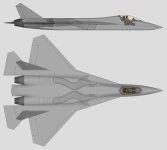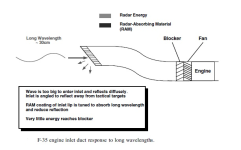Although IAF may have concepts in mind, I think they will keep changing their minds until new information is revealed to them. The industry will have to lead that, they can't do it on their own. They should have a general idea up to AMCA and its drones; Ghatak, FUFA, ISR drone, EW drone, tanker drone etc. Beyond that is anybody's guess.
Developing our own engine requires materials research for 30+ years before beginning a program. We have been doing that since the 80s, so we should have something to show for it today. F414 will eventually have Indian hot parts, so we could have something by next decade. So technologies developed in the last 15 years could end up on AHCA's engine. The Chinese materials developed in the 60s were used in the WS-10 in the 90s. And then getting that right, testing it and certifying it will take 20 years. The Russians took 22 years to develop and field Su-57's Type 30. AMCA's engine is simpler, it will use technologies that already exist in the West, to the point of being introduced by the end of the decade. For example, the F414's new CMC core or SCAF demonstrator's 11T M88 version.
American engines have lifespan of at least 4000 hours with MTBO 2000 hours. F-22's F119 is quoted to have 8650 hrs lifespan.
IDK the exact process of testing & certification.
- But If they are static tested for 1 hour every 2 hours then staff in shift duty can test it for 8 hours/day. It would take 500 days to complete 4000 hours testing. May be at least 2-3 pieces will be tested together. More models would be made with different # of LPC, HPC stages with different OPR, BPR & other design attributes.
- Then after finalizing 1 model best suited, they would take it on flight testbed, a small to medium cargo jet with 4 engines. Let's make it another 500 days.
- Then they may test it on a 2 engine fighter jet capable of landing on 1 engine. Let's count another 500 days.
A little over 4 years pass by. Beyond this IDK why would it take 20 yrs. I can understand 5-7 yrs. Critical core tech should be built with highet priorities.
Most of our politicians of every party are uneducated, improperly educated, acting like mafia or with mafia. And citizens also try to evade tax illegally. So obviously R&D funding suffers for decades.
GTRE & Safran need to work tightly now.
Till then if we can get either Al-51 w/o ToT or AL-41 from Russia, or F110 perhaps from USA, then we should proceed immediately for AHCA.
The replacement cycle is very long. MKI, MRFA, LCA Mk2 and AMCA are 50 years. LCA Mk1/A is at 30-40 years, the same as Mig-21. So LCA Mk1/A and MKI will need replacements from 2055. AMCA and MRFA will need replacements from 2085. Mig-29 and M2000 are also on a 50-year cycle, with replacements coming in from 2037 or so. So after AMCA, the way we develop fighters will change completely, similar to US and Russia.
The service life of each jet is so long hence we need to evolve them incrementally faster. Each century is so different from previous one. We had to start with LCA due engine problems.
As for 7th gen, with stratospheric capability, such aircraft are gonna come in soon. Russia's PAK DP and US' SR-72 will be among the first. China could follow them. ISRO's developing scram-jet based RLV with more advanced capability by 2030, which means DRDO/ADA should be able to replicate some of it by 2040 for military use. Once PAK DP comes in, the Americans and Chinese will follow-through with their own designs very quickly. We could actually end up 15 years behind them due to AHCA's 2055 deadline. Dassault has also suggested developing such technologies.
PAK-DP is quoted as high-supersonic,not Hypersonic.

And with SR-72 we need to understand how exactly a Mach-6-8 jet would attack. The shockwave sonic triangle is so high swept back & the friction would heat the airframe so much, how can a weapon be launched from IWB, nobody has shared any tech article on it.
Moreover its IRS will be huge visible to satellites. It will need big amout of fuel like SR-71, so it will be a big jet itself. I don't think SR-72 coming before NGAD.
Anyways, let's discuss hypersonic in its own thread
Dear admins, i request to merge all non-Indian Hypersonic threads together. When i searched for "hypersonic" in titles i found 16 non-Indian threads.
(
Search results for query: hypersonic)
They are in following 2 domains -
World Defence > Military Technology
Technology | Education | Space Studies | Economy > Science and Technology
7gen tech will need its own thread too. Technology also has its time. If it arrives before time then also it fails.
The Su-57 uses a radar blocker, has an S-duct and can cover its blades with a variable inlet.
Probably lets it done when it's not supercruising at mach 2.
Yes, the LEVCONs are part of the wing, so the effective change in RCS is almost the same as the wing. It doesn't add to the RCS.
As we can see from real photos & CAD above, the duct is not curved enough like in F-22 for example. The fans/blocker should not be visible.
The variable inlet ramp is primarily for reducing supersonic air to subsonic air before entering engine. It can be painted with RAM & apparently is painted but RF radiation doesn't work exactly like light reflected by perfect mirror. So compared to ideal S-duct like in F-22, here relatively the RCS will be more. Also, the CAD above is shown slightly elevated, above the horizontal. After lowering the ramps also the blocker will be visible at horizontal & from lower 5-10 degree angle, something like below blueprint:

Till PAKFA was revealed properly, there were many speculations. 1 of those was following with S-duct:




















